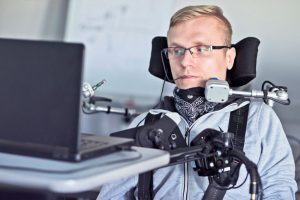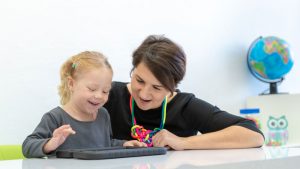Augmentative and Alternative Communication is Giving Non-Verbal Students a Voice in Mainstream Classrooms
8/17/2020

How Integrating a Means of Communication Can Benefit Social and Academic Development for Special Needs Students
Within the next few weeks, students are expected to return to classrooms across America. With the Covid-19 pandemic leaving everybody scrambling for remote learning and teaching solutions just as the school year was coming to an end, it's not completely clear how students and teachers will engage in teaching and learning as the 2020-21 school year begins. One thing is certain: students will have a lot more on their minds than they did last fall.
For the majority of our students, regular verbal communication is easy; some would even point to how difficult it can be to get a classroom to quiet down and how sometimes it seems like all they want to do is talk. With these kids, of course, all that talk is supplemented with voice inflection and modulation, not to mention gesticulation and body language. And it all effortlessly comes together to allow them to communicate and dramatically emphasize anything they wish to share.
These aren't the kids we're worried about; in fact they are the model of what we want to help our non-verbal kids achieve. It's these non-verbal kids who need some way to experience the joy of being able to freely communicate, and it's augmentative and alternative tools and techniques that are allowing them to do just that.
Getting Students, Faculty and Parents On the Same Page with Using Alternative Means of Communication

One speech pathologist made it easy for her team to understand why alternative and augmentative communication tools are so important, summing it up like this: "We would never put duct tape over a child's mouth and expect them to learn and participate in class. Likewise, if we have a student with a communication device, it is imperative everyone learns how to use it."
As educators, we cannot allow a student's ability to "talk" to be stifled in any way. If we do, we are limiting a precious ability from someone who, more than likely, has a lot to say. The ability to communicate really is a fundamental part of the human experience.
It's not good enough for the non-verbal student to be familiar with how these tools and systems work. For these devices and alternative methods to function to their fullest potential and for the communication itself to be as natural and effortless as it is for the rest of us, teachers and classmates need to understand how they work too. And perhaps most importantly, parents need to be comfortable enough with the technology to use it at home. The good news is that these tools are more and more taking the form of software that resides on the phones and tablets that most of us already use every day.
But that hasn't made the adoption and regular use of the technology an absolute given. Devices have been known to be found left in backpacks, drawers, and desks without ever having been touched. One colleague of mine even found a brand new tablet, still in its box, in a student's backpack. When the parent was asked why it wasn't being used at home, the parent indicated that they had no idea how to even turn it on.
In cases where parents are slow or unwilling to adapt to the use of this technology, the solution may need to come from an outside expert. This was the case in the situation that my colleague shared with me. Very quickly, she was happy to tell me, the speech pathologist did a home visit and invested time to teach the family and student how to power up the device and use the critical software.
Within a week or two, the student was an enthusiastic user and was happily communicating with staff and peers.
What Does the Law Say?

Even if using devices is something that doesn't come natural to some teachers, the decision to do it as a way to support communication efforts is a pretty easy one. That's because teachers are legally obligated to honor the Individualized Education Program of students in their class. According to IDEA rule 300.323, provision of services begins immediately after development of the program, no questions and no excuses.
The school and district are required to honor whatever the IEP team decided was best and would most appropriately meet the student's needs. If a teacher requires education to learn to use any tool or support for activities of daily living, the special education team will do their best to provide any necessary coaching or training.
By Solving Lots of Small Communication Problems, Augmentative Tools Can Quickly Become a Normal Part of Life
The literature notes two broad categories of people that would benefit from augmentative and alternative means of communication: people with congenital disabilities and people with acquired disabilities:
- Congenital disabilities would represent disabilities with which people are born and include Autism, genetic disorders, intellectual disabilities, Down Syndrome, developmental disabilities, cerebral palsy, developmental apraxia of speech, etc.
- Acquired Disabilities include traumatic brain injuries, acquired brain injuries, neurodegenerative diseases like ALS (Lou Gehrig's Disease), a post-operative disability, or various temporary conditions such as with the removal of a breathing tube following surgery.

There are two classifications of augmentative and alternative communication methods:
- Unaided communication is typically low-tech and ranges from gesticulation, facial expressions, body language, vocalizations ("chirping"), to chatter unique to the individual, which someone familiar to that person will recognize and understand.
- Aided speech relies on images, 3-D objects, written word, story boards, and books. More high-tech tools include speech generating devices (SGD), software, and apps. The use of digitized and synthetic speech tools to augment the use of text-to-speech on computers can give people a literal voice. For many students, the sense of truly being heard has been a catalyst for feeling a sense of belonging with their peer groups.
Using augmentative communication devices will come really naturally to kids who have solid receptive language skills since they understand that when a question is asked, a response is required. But for students that have more limited communication skills or who are just starting out, these devices can play an even more important role in facilitating vital one-way communication.
Teachers involved with young learners must assume the responsibility for building vocabulary even if a child is not talking. When starting out with augmentative and alternative communication, the system is more demand-based. "Give hat." "Go grandma's," etc.
Without any way to express a very basic need or desire like this, a child may become angry or agitated, sad or withdrawn. With the right augmentative communication tools, all that goes away as the child uses the device to speak, explain and convey things free of frustrating limitations. It's imperative, then, that the tool itself doesn't place any limitations on the child's ability to communicate- so it's important that all the words in the child's vocabulary are stored on the device, or the right images representative of those words, as the case may be.
Imagine for a moment how it would feel if someone brought a fresh baked box of donuts into the break room and you couldn't ask for one. With the right app, a student can find both a picture of a donut as well as the word.
As a child ages and vocabulary increases, images and words share a space on the chart. Eventually, when reading skills develop, it evolves into words only.
Covering the Cost of Some of the Most Popular Tools and Apps

Medicare and Medicaid will, in many cases, pay for these items, and depending on where you live, both apps and devices could be paid for by the county or school district. Grant opportunities and private pay are also options for some.
Go Talk offers an easy-to-use preloaded device complete with software that starts at around $250. The Go Talk app is also available separately for download on Apple devices.
Touch Chat (Apple devices only) starts around $300 and real-life images can be uploaded from a phone or other device.
Prologquo2Go is a symbol-based program costing around $250 and runs on Apple devices only.
Practical Tips For Implementing Alternative and Augmentative Communication Technology in the Classroom and at Home

If you're ready to harness the power of these tools for your student or child, here's a quick reference list of some strategies and best practices I would recommend based on my experience using augmentative and alternative communication devices and software:
- Make sure vocabulary is age appropriate. Example: a middle school student will want, "I'm so over it" or "Hey, what's up." Being Autistic doesn't mean you don't know what's going on around you. These kids want to use the same figures of speech their peers are using, and they should be given the chance to blend in as best they can.
- If a caregiver is not tech-savvy, there is a tremendous learning curve. Connect with your child's teacher, a speech pathologist, or call the tech support hotline associated with the app/software. YouTube is a help, too.
- For Autistic people who are aggressive, there is a consideration of replacement cost because an iPad may be thrown during a meltdown.
- Taking away the device as punishment is essentially removal of a person's voice. I strongly advise against this.
- Make sure the device is always accessible and charged.
- Make sure to do frequent software updates. Generally updates are free.
- Make sure the volume of the device is turned up to an appropriate level for the environment. If a student is in gym class and is trying to answer a question, acoustics may require the device be turned up.
- Be sure to save your information stored in the app to the cloud. My best friend's kid had built an extensive list of places, names, colors, locations, shapes, types of cars, types of food, and his favorite movies. It was all lost and needed to be rebuilt.
- If you choose GoTalk, a "book" of developed vocabulary can be shared with others. Examples include favorite movies, favorite toys, etc.
- Many programs can access photographs from your mobile devices to create a more relatable, real-world experience.
- Start using these tools soon after recognizing the child is non-verbal. As they learn and grow with the tools and devices it will become second nature and they'll get the most out of it over the long term.
- Build pages in the app based on who, what, when, where, why, and how so it's easier for them to provide responses appropriate to the question they are asked.
- Build pages in the app with categories such as feelings (I don't want to talk right now, my stomach feels funky, etc.). My six year old nephew's favorite phrase is, "Not now, Nana." Everyone gets a chuckle out of that and we can clearly see his sense of humor shine.
- Matching words with objects, words with numbers, knowing letters, etc. Do so from a visual perspective.
- The device should travel everywhere with the student because it is their voice. Be sure it has a durable case and is protected when not in use.
- Some cases have built-in speakers to make responses louder which can be helpful while outdoors or on the playground.
- Speaking of playgrounds, communication boards are popping up on playgrounds across the country. This allows a student to leave their device in the classroom and be able to play hands-free with their general ed. peers. Making connections is the name of the game!
- It's better to have too many vocabulary words than not enough.
Augmentative devices come in a variety of shapes, sizes, forms, and models. But all of them do the same thing by giving a voice to the voiceless. Parents, teachers and students need to work together to learn which tools will work best for the student, and be prepared to put in the work it takes to get comfortable with how it all works. Students who have difficulty with expressive language, in particular, will need a lot of coaching and support. Although you might get a little exhausted with the amount of repetition required, the moment the student begins to gain independence, you'll realize it is well worth the time and effort.
- Dear Novice Teacher:An Open Letter About What You Really Need To Know For a Successful Teaching Career - November 9, 2021
- I Never Forgot What It Felt Like to Struggle in School… So I Decided to Become the Teacher I Always Wished I Had - October 8, 2021
- The Issue of Bullying Students with Disabilities Hits Particularly Close to Home for Me - August 16, 2021









